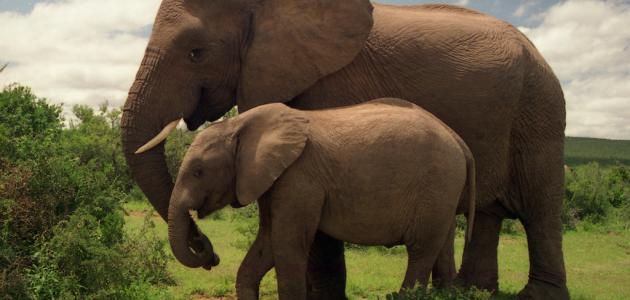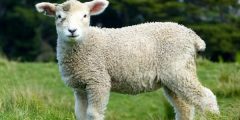the elephant
The elephant (in English: Elephant) belongs to the placental mammals and the order Proboscis. Characterized the elephant With a huge head, large ears, and its thick skin contains sweat glands. Therefore, it resorts to spraying its body with water to cool it. There is a bundle of hair at the end of its tail, and some villi around the ears, eyes, and mouth. It has legs that resemble columns, and its feet contain a fleshy pad. The length of the hose the elephant Approximately 1.5 m tall, and weighs 140 kg. It is formed by the elongation of the nose, which is connected to the upper lip, and consists of a strong fleshy mass devoid of bone. It is used the elephant Its trunk is for sniffing, breathing, eating and drinking, throwing water over its body when bathing, and grasping things. He can pick up a small coin with it, carry something weighing 270 kg, and the mother also uses it to caress her baby.
Elephants are vegetarians; They eat 64 types of plants, such as: tree leaves, branches, fruits, and roots. They prefer to eat coconuts, dates, bamboo, maize, peaches, and sugar cane, and their appetite is proportional to their size. It can eat 140 kg of food and drink 150 liters of water daily.
There are two types of elephants: African elephants and Asian elephants. African elephants live south of the Sahara, in the African coast, and in the rainforests of central and western Africa, while Asian elephants live in Southeast Asia, Nepal, and India. Elephants live in herds, ruled by the eldest female in the herd, known as the matriarch. The herd consists of only females and young elephants, while adult males roam separately from the herd.[XNUMX]
Read also:What is the tallest animal in the worldThe name of the son of an elephant
In the Arabic language, the son of an elephant is called a daghfal (in English: Calf).[XNUMX] A female elephant gives birth once every 4-5 years, after a gestation period that is the longest among mammals. The duration of pregnancy reaches 22 months.[XNUMX] When a baby elephant is born, it is covered with hair, has a long tail, and a short trunk. Its height is 3 feet, or one meter, and its weight is approximately 91 kg. Then the weight of the babies increases by 1-1.3 kg per day during the first year, and they continue to be breastfed by their mothers for two or three years. Baby elephants spend time playing, and in the process they learn to use the trunk, move their ears, and control the movement of their feet.[XNUMX][XNUMX]
The relationship between the mother and her young is very close, and if the young is female, it will remain with the mother until her death, but if it is male, he will be removed from the group of females at puberty. That is, at approximately 12 years of age; Because he will then become aggressive and start fighting with the rest of the elephants.[XNUMX]
The difference between African and Asian elephants
Among the differences between African and Asian elephants are the following:
- The African elephant is larger than the Asian elephant, as it is the largest land animal. Its weight ranges between 2.5-7 tons, and its height ranges between 8.2-13 feet. As for the Asian elephant, its weight ranges between 2.25-5.5 tons, and its height ranges between 6.6-9.8 feet.[XNUMX][XNUMX]
- The ears of the African elephant are larger and take the shape of the continent of Africa, while the ears of the Asian elephant are round in shape.[XNUMX]
- At the end of the trunk of the Asian elephant there is a fleshy, finger-shaped protrusion, while the trunk of the African elephant has two protrusions.[XNUMX]
- Domestication of the African elephant is possible, but difficult. On the other hand, humans have been able to use the Asian elephant for thousands of years in wars and to carry heavy objects and humans as well.[XNUMX][XNUMX]
- The average lifespan of an African elephant in the wild is 70 years, while the average lifespan of an Asian elephant is 60 years.[XNUMX][XNUMX]
- Male and female African elephants have tusks, while female Asian elephants do not.[XNUMX]
- The skin of the African elephant is more wrinkled than the skin of the Asian elephant.[XNUMX]
- Asian elephants have five toenails on each of their front feet, and four on each of their back feet, while African elephants have four toenails on each of their front feet, and three or four on each of their back feet.[XNUMX]
Read also:Specifications of purebred Arabian horses
Elephants and humans
Elephants are among the smartest mammals, and they are sensitive. She has complex feelings. Young elephants are captured from the wild and trained to work in the forests. To carry trees using their hoses, Indian kings have used them in wars since the beginning of the fourth century. Asian elephants are known to be more trainable and domesticated than African elephants. Therefore, the elephants that we see in zoos and circus tents are often Asian elephants. Despite this, Commander Hannibal used African elephants to cross the Alps, and the famous elephant Jumbo was an African elephant, an elephant that toured America at the end of the ninth century, and is found in Thailand. Burma has elephants called white elephants, which are not actually white, but their skin color is much lighter than other elephants.[XNUMX]
Threats and risks
Elephants have an important role in preserving forests and increasing biodiversity in ecosystems. However, they are exposed to many risks and their numbers are decreasing, which has called on the World Wide Fund for Nature (WWF) to protect and support them. The most important of these risks are as follows:[XNUMX]
- poaching; This is to obtain ivory, which is why the Convention on International Trade in Endangered Species of Wild Fauna and Flora (CITES) banned international trade in ivory. However, there is a rise in the rate of illegal hunting of elephants. To meet the increasing demand for ivory from Asian countries.
- Habitat loss and degradation; Elephants lost much of their habitat and the roads they cross during seasonal migrations. This is due to the expansion of humans in building colonies, farms, and creating infrastructure, such as: roads, canals, and pipelines.
- Conflict with humans, which results from elephants attacking human farms.
Read also:What does it mean to domesticate animals?
solutions
A number of solutions were agreed upon to protect elephants and reduce the risks they threaten, namely:[XNUMX]
- Building protected areas within the natural elephant areas, increasing the effectiveness of their management, training their guards, and providing them with the necessary techniques to monitor elephants and patrol the protected areas. To combat illegal fishing attempts.
- Reducing conflict between elephants and humans, by helping local communities protect their crops from elephants, by building fences, using monitoring and early warning devices, and educating communities to be able to live side by side with them. The elephants.
- Proper planning of the lands used by elephants in their seasonal movements, and building fences to protect infrastructure that serves humans.
- An agreement was reached with the government of China regarding issuing a law banning ivory trade in 2017, as part of the government’s efforts. To reduce the demand for elephant ivory, and get rid of the global poaching problem.









